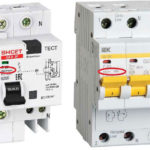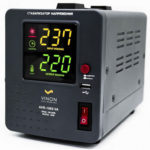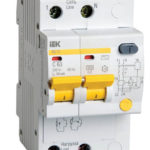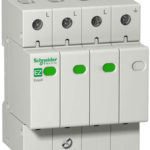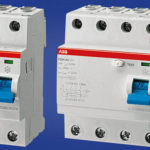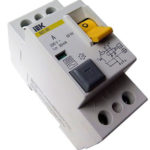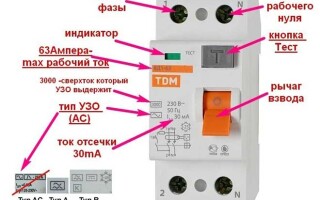Residual current device (RCD) prevents fire due to current leakage, and also reduces the risk of fire from it. This device is popular both for installation in apartments and for private houses. And RCD for an apartment built using modern technologies is mandatory.

Content
The purpose of the RCD and the principle of operation
It is important to understand that this device protects against excess current, and not against voltage surges and short circuits. At the same time, a circuit breaker protects the electrics in the house, and a residual current device can provide a reduction in the risk of electric shock.
The RCD is not designed to protect against short circuits, so it is imperative to connect a circuit breaker to it. Before you decide which RCD to choose, you need to know its design and principle of operation.
There are several coils inside the case.One coil is connected to the phase, the other to the neutral wire. The current passing through the coils creates magnetic fields. Since they are directed in opposite directions, they destroy each other. If the current passing through one of the coils is stronger than it should be, then an excess field is formed, which directs it to the third coil. When the third coil starts to work, the RCD protection works as intended and turns off the electricity in this area of \u200b\u200bthe house.
Based on the principle of operation of the device, the question is how to choose the right RCD for a house and apartment.
Main characteristics of the device
In order to determine which RCD is the best, when buying it, it is necessary to take into account all the parameters and technical characteristics.
After the manufacturer's information and brand name, performance data and ratings are applied to the case, such as:
- Name and series. The inscription does not have to contain the word "RCD", many manufacturers call it "VTD" (residual current switch).
- Rated voltage value. It must be single-phase (220 V) or three-phase (330 V) at a standard frequency of 50 Hz. If the device is chosen for a private house, then you need to take one that is designed for three-phase voltage.
- The rated operational current is the maximum value that the protective device is capable of processing. There are devices for 16, 20, 25, 32, 40, 63, 80 and 100 A.
- The rated differential current is the value of the leakage at which the protection is activated and the electricity is automatically turned off. This value can be in 6 mA, 10 mA, 30 mA, 100 mA, 300 and 500 mA.
There is a marking on the case that tells about additional characteristics:
- The value of the rated conditional short circuit current is the maximum short circuit at which the RCD can continue to function normally, provided that an auto switch is additionally installed with it.
- Protection response time. This is the period of time from the occurrence of a leak to its elimination, during which the protection is triggered. The maximum value is 0.03 s.
- Mandatory device diagram.
How to choose the right RCD by parameters
The choice of RCD must be carried out, paying attention to its rated and differential operating current.
Rated - this is the current for which the operation of the power contacts is designed. If it is increased, they may fail. Differential is the tripping current of the residual current device, that is, leakage.
Before choosing an RCD, it is useful to find out its price, quality and performance and compare these three parameters. Since it can be difficult for a non-professional to choose an RCD in terms of power and quality, experts advise compiling a table of parameters for the devices you like and using it to choose a device with the best characteristics.
Rated current
When selecting according to the rated current, you need to know that the device is always placed in series with the circuit breaker to protect the power contacts from overload and short circuit. When one or the other occurs, the device does not work, as it is not intended for this. Therefore, it must be protected automatically.
The next thing you should pay attention to: the rated current should at least match the one declared for the machine, but it is better to be 1 step higher.
Residual current
There are two important things to remember here:
- For electrical safety purposes, a differential trip current of either 10 mA or 30 mA is always selected. For example, a 10 mA RCD can be installed on one electrical receiver. At the entrance to the house, a device with this value may work too often, since the electrical wiring in the apartment has its own leakage limits.
- All other RCDs with a differential current above 30 mA are used for fire fighting purposes. But when installing a 100 mA RCD at the input, a 30 mA RCD must be installed in series with it for electrical safety purposes. In this case, it would be advisable to install a selective RCD at the input so that it operates with a short time delay and makes it possible to operate a device with a lower rated current.

Product type
According to the form of current leakage, all these devices are classified into 3 types:
- Device type "AS". This device is common because of the more affordable price. Operates only when a sinusoidal current leakage occurs.
- Type "A" device. It is designed to operate with an instantaneous or gradual appearance of excess current, which has a variable sinusoidal and pulsating constant form. This is the most sought after type, but is more expensive due to the ability to control both constant and variable flow.
- Type "B" device. Most often used to protect industrial premises. In addition to responding to a sinusoidal and pulsating waveform, it also responds to a rectified form of constant leakage.
In addition to these main three types, there are 2 more:
- Selective device type "S".It does not turn off immediately, but after a specified period of time.
- Type "G". The principle is the same as the previous one, but there the time delay for shutdown is slightly less.

Design
By design, 2 types of RCDs are distinguished:
- electronic - working from an external network;
- electromechanical - independent of the network, it does not need power for its operation.
Manufacturer
An equally important criterion is the choice of the manufacturer. The question of which RCD company is better to choose must be decided by the buyer himself. The following options are recommended:
- Legrand;
- ABB;
- AEG;
- Siemens;
- Schneider Electric;
- DEKraft.
Among budget models, Astro-UZO and DEC have the highest quality.
Similar articles:
